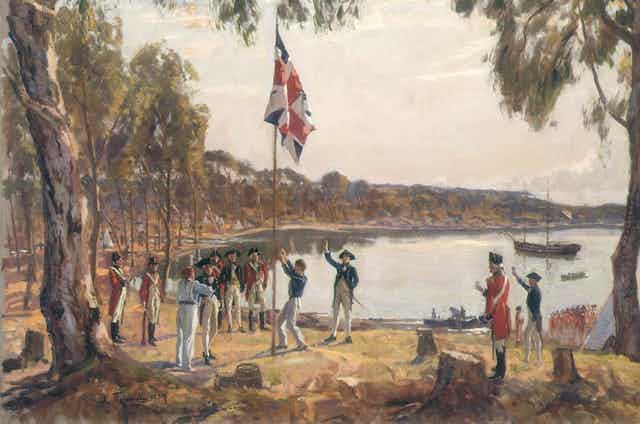Much has been made in the last few days of the University of New South Wales’ “diversity toolkit” offering teachers guidelines on Indigenous terminology.
The most controversial directive was a line about using the term “invasion” to describe Captain Cook’s arrival here:
Australia was not settled peacefully, it was invaded, occupied and colonised. Describing the arrival of the Europeans as a “settlement” attempts to view Australian history from the shores of England rather than the shores of Australia.
This story made the front page of The Daily Telegraph. Radio personality Kyle Sandilands quickly condemned it as an attempt to “rewrite history”.
But detailed historical research on the colonial frontier unequivocally supports the idea that Aboriginal people were subject to attack, assault, incursion, conquest and subjugation: all synonyms for the term “invasion”.
This was particularly the case in Queensland, where the actions of the Native Mounted Police were designed to subjugate Aboriginal resistance to European “settlers” on their traditional lands, and to protect pastoralists, miners and others from Aboriginal aggression.
The UNSW guidelines are not “rewriting” history – they are simply highlighting a history that has never been adequately told in the first place. This history is one that certain sections of Australian society are determined to deny, led by conservative media commentators who recently whipped up an indignant storm about how a university chooses to educate their students.
It is telling that Sandilands suggested people “get over it – it’s 200 years ago” when we so revere the notion of Lest We Forget when remembering our role in a foreign war (WW1) 100 years ago.
It is also worth remembering in this context that large-scale massacres of Aboriginal people were still being carried out through the 1920s and early 1930s in some parts of Australia.
A newly begun project focusing on the archaeology of the Queensland Native Mounted Police and Indigenous oral histories will look at the physical evidence of frontier conflict, including the range of activities undertaken by the Queensland Mounted Police, and the effects of their presence on both Aboriginal and non-Aboriginal people.
The first step will be to listen. As Jangga Elder Colin McLennan, from Central Queensland, said in a recent project meeting:
this subject has been left idling too long. Aboriginal people are very sensitive about what happened. We need to investigate these places and we need to talk about them openly and honestly … I’ve kept a lot of this knowledge in my head about Aboriginal people being slaughtered and the locations of the killing fields in my country. It’s like an open wound that needs to be healed and it needs to be dealt with. This history belongs to all of us. We need to share it with each other.
In a way, Sandilands isn’t trying to deny the scale of frontier conflict (although many do) – he just wants us to forget about it. But who we, as Australians, choose to remember and what events we commemorate are inherently entwined with how we view ourselves and how we want the world to see us as a nation.

Official records of the Coniston massacre, which took place in the Northern Territory in 1928, admit to 31 Walpiri, Anmatyerre and Kaytetye men, women and children being killed by Constable William Murray and his men. Is not an event on this scale – which happened just 88 years ago – worth remembering? Is not a Walpiri man’s death defending his way of life just as worthy of remembrance as a World War I digger’s ten years earlier?
Why are we as a nation so reluctant to face up to this part of our past? Inconvenient truths that risk tainting the white “pioneer/settler” narrative are, it seems, not to be commemorated but forgotten.
Although the historical record documenting frontier conflict is a powerful and unequivocal record of our colonial past, it is mostly limited to written records that largely exclude Indigenous voices.
Yet the magnitude, persistence and near-universality of Aboriginal oral narratives of frontier violence are surely telling.
Combining the material evidence for frontier conflict through archaeology with written records and Aboriginal oral tradition and memory might be the one way to track events and their repercussions more clearly.
Along with oral tradition, monuments and sites are powerful tools in remembering. They are physical markers on the landscape of events that happened.
For many Indigenous communities, the physical evidence of frontier conflict in Queensland in the form of Native Mounted Police camps and locations where people were killed are — just like Gallipoli — important places of remembrance that should never be forgotten.
Hopefully one day non-Indigenous people will be able to visit these sites and reflect on our collective history, rather than being threatened by it.
Professor Bryce Barker is part of an ARC-funded archaeological study into the activities and legacies of the Queensland Native Mounted Police, along with Assoc. Professor Heather Burke, Professor Iain Davidson, Dr Lynley Wallis, Dr Noelene Cole, Elizabeth Hatte and Professor Larry Zimmerman.

